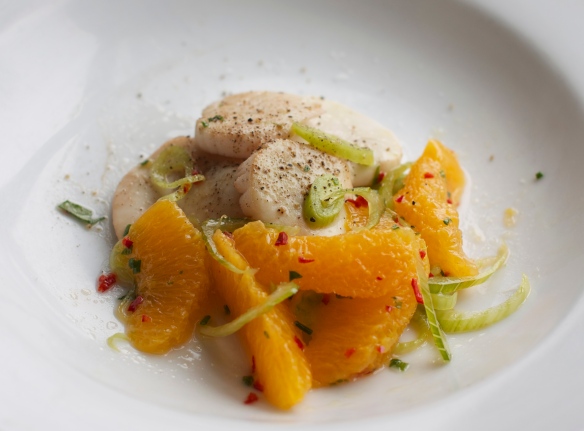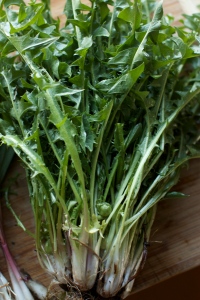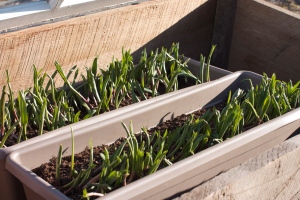Pork Chops with Orange-Rhubarb Sauce and Lovage; Rhubarb Marinated Sea Scallops with Orange-Fennel Salad; Fresh Oysters with Rhubarb Mignonette Sauce
Rhubarb is spring’s own zucchini. By which I mean, even if you don’t have your own patch of rhubarb, chances are good you have a neighbor who is swimming in the stuff every year at this time, and who will eagerly foist some off on anyone who asks. That’s because rhubarb seems to live forever, and most folks who live in old houses in New England have an ancient plot that came with the deed. These well-established clumps produce a huge number of juicy pink stalks year after year without any attention at all – though they do like moisture, lots of sun and an occasional infusion of compost.
Rhubarb is sometimes called the “Pie Plant,” for obvious reasons. But rhubarb isn’t just for pies. In fact, it has the kind of versatility that most other edibles lack, happy in desserts as well as savory dishes, good both cooked and raw, delicate enough to take a supporting role in a recipe, and assertive enough to take center stage.
Though many people wrinkle their noses when contemplating the acidity of rhubarb, especially in its raw state, that acidity is probably rhubarb’s best asset. You might not want to eat rhubarb the way Scandinavians do – by the raw stalk, dipped in sugar – or as Chileans do – by the raw stalk dipped in salt and hot dried chile pepper. But if you think of rhubarb as a substitute for citrus fruits like lemons and limes, or as a balancing ingredient in recipes that feature rich foods like pork and shellfish, you will certainly find dozens of ways to substitute rhubarb into your favorite recipes.
Below you’ll find a few recipes I’ve developed for using rhubarb in savory dishes. The first, Pork Chops with Orange Rhubarb Sauce and Lovage, contains another of spring’s vegetable perennials, lovage. Lovage looks like giant celery and tastes like it looks, which is to say a tiny bit of it imparts a highly concentrated celery taste. Used sparingly, it is a wonderful addition to salads, soups and other dishes. Substitute celery leaves or parsley, if you don’t have any.
The second recipe uses rhubarb juice to partially “cook” fresh scallops, just as lime juice is used in seafood ceviches. The longer the scallops marinate, the more the acid will permeate the delicate flesh, and the less time the scallop will need to heat to be cooked through. If you like, scallops that have been marinated for 4-6 hours can be served cold, without the final cooking step. However, I prefer the lovely contrast the warm scallops create juxtaposed to the cold, crunchy fennel orange salad.
The final recipe is my take on a traditional sauce for oysters, mignonette. Usually mignonette sauce is made by combining red wine vinegar, minced shallots and lots of freshly ground black pepper. Here, to balance the tartness of rhubarb, I’ve substituted a mellow-sweet balsamic vinegar (buy a good one – it’s expensive, but worth it) for the sharper red wine vinegar. The resulting sauce is wonderful, not just on oysters, but with any rich food. I’m particularly fond of it spooned over a slice of crusty bread spread with a triple crème cheese, such as Saint André.
Pork Chops with Orange-Rhubarb Sauce and Lovage
- 4 boneless pork loin chops (or a small loin roast cut into four slices)
- salt and pepper
- 1 tablespoon butter or cooking oil (you may need more if cooking in batches)
- 2 large shallots or one small onion, minced
- the juice of 2 large oranges (about 1 cup) and the grated rind of 1 orange
- 2 cups chopped rhubarb
- 1/2 cup golden raisins (optional)
- 2 tablespoons sugar (or to taste)
- 1/4 cup heavy cream (optional)
- 1/4 chopped lovage leaves plus lovage sprigs for garnish (you may substitute parsley or celery leaves)
If possible the day before serving, sprinkle both sides of the pork chops with salt and pepper, lay them on a paper towel on a plate, cover with another paper towel and leave in the refrigerator overnight. This dries the outside of the pork and allows it to absorb a bit of salt, which will cause the meat to brown nicely and remain juicy when cooked.
Heat a large skillet over medium heat and melt the butter or heat the oil in it. Add the pork chops to the pan, working in two batches if necessary so as not to crowd the meat. When one side is golden, flip the chop and cook the other side, covering the pan to avoid splatters and to cook the meat more quickly. Thick chops will be done in about ten minutes total. Don’t overdo it, as the chops will be resting in a warm place while the sauce is prepared and will continue to cook from residual heat.
When the chops are cooked, set them aside in a warm spot while making the sauce. Add the shallots to the skillet in which you have cooked the pork – if there’s a lot of fat in the pan from cooking, you may pour most of it off. Or, if there is no fat left in the pan, you may add another pat of butter or bit of oil to it before cooking the shallots. Cook the shallots until they wilt, but don’t brown them.
Add the orange juice to the pan and stir well to scrape up the bits of cooked meat juice from the bottom of the skillet. Add the orange rind, rhubarb and raisins and stir well. Turn the heat down so the rhubarb simmers slowly. When it begins to break down after a few minutes, taste the mixture and add as much sugar as needed to balance the sauce. Stir in the heavy cream, taste again and add salt and pepper to taste.
Divide the sauce between four plates, top each bed of sauce with a pork chop, sprinkle a little lovage over the sauce and garnish the top of the chop with a sprig of lovage. Serve immediately.
Serves 4.
Rhubarb Marinated Sea Scallops with Orange-Fennel Salad
- 1/2 pound sea scallops
- 1/2 pound of rhubarb, cleaned and chopped into pieces
- 2 tablespoons chopped fresh chives
- 2 tablespoons chopped fresh parsley
- 1/4 teaspoon dried hot red pepper flakes (or to taste)
- 3 tablespoons good quality extra virgin olive oil plus a little more for cooking the scallops
- 2-3 oranges, skinned and divided into sections
- 2-3 baby fennel bulbs or 1 regular fennel bulb
- salt and pepper to taste
Cut the tough piece of white muscle from the scallops (if necessary) and discard. Slice each of the scallops into three thin rounds. Put the rounds into a non-reactive bowl.
In the bowl of a food processor, pulse the rhubarb until it is pureed (you may also use a grater to turn it into a puree). Put the puree into a fine sieve over a bowl and press on it to extract all the juice from it (you may also do this by squeezing the puree with your hands.) You should wind up with about 3/4 of a cup of juice. Pour this over the scallops, cover with plastic wrap and refrigerate for at least an hour or up to 6 hours. Discard the rhubarb solids.
Wash the fennel, then slice it into very thin slivers and toss with the orange segments. Mix together the chives, parsley, olive oil, hot pepper, a little salt and pepper and set aside. Remove the scallops from the refrigerator and drain, discarding the rhubarb juice.
Heat a skillet, add a little oil to it and then saute the scallops over very high heat, less than a minute on each side. The longer they have marinated, the less time they will need to cook.
Arrange the scallops and orange salad on 4 plates, drizzling them with a little of the oil and herb sauce. Serve immediately.
Serves 4 as an appetizer.
Fresh Oysters with Rhubarb Mignonette Sauce
- 1/4 cup excellent quality balsamic vinegar
- 1/4 cup finely minced shallots
- 1/4 cup finely minced fresh rhubarb
- plenty of freshly ground pepper (to taste)
- 1 dozen fresh oysters on the half-shell
Combine all ingredients. Serve chilled on fresh oysters or other raw shellfish. The sauce is also delicious on fresh crusty bread thickly spread with butter or a soft, rich cheese, such as Saint André.
Makes a bit more than 1/2 cup.











